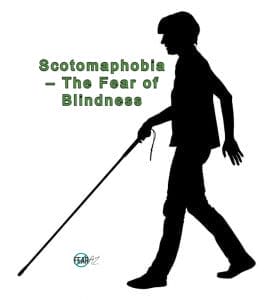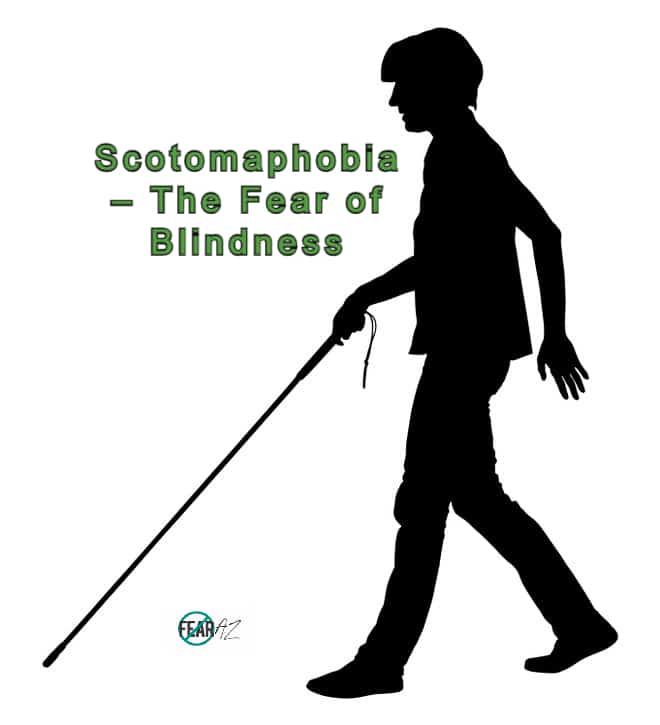Share This Article
The Fear of Blindness Is Known as Scotomaphobia
Some 285 million people worldwide are visually impaired. Now, that statistic makes blindness a serious concern. However, that concern takes a wrong turn when it becomes a phobia that’s hard to manage.
We all fear becoming blind when we come across a situation that threatens our sight. But sometimes that fear reaches extreme levels to the point where people are constantly terrified of blindness. This is called scotomaphobia, or a fear of blindness.
Scary, right? But fortunately, it’s curable. You can vanquish your irrational fear of blindness by learning to manage your thoughts. Explore all about your fear and the ways to beat it below.

What Does Scotomaphobia Mean?
People often take cautious measures to avoid straining their eyes. Scotomaphobia involves weaving one’s life around these cautious measures to protect eyesight. So, what does scotomaphobia mean? Scotomaphobia is the intense fear of blindness. Scotomaphobia is derived from the Greek terms scotoma meaning blindness and phobos meaning fear. It is a specific phobia. Specific phobias are phobias of specific objects or situations, in this case, blindness. Those suffering from scotomaphobia experience extreme anxiety when exposed to a situation they feel may visually impair them.
In severe cases, being in an exposure situation is not necessary to trigger a reaction. Just the thought of becoming blind can trigger anxiety and stress in some. This uncontrollable anxiety can even lead to panic attacks. To avoid these extreme levels of stress, you might avoid situations that can trigger anxiety. You evade your intrusive thoughts not by coping with anxiety but by avoiding trigger situations. This can often affect your entire lifestyle. When you resort to such avoidance behaviors repetitively, it can lead to obsessive-compulsive disorder (OCD). You develop a compulsive need to keep doing certain things. These behaviors also affect your social and professional life.
What Causes Scotomaphobia?
One may fear blindness because of the helplessness it can lead to or the deeply unpleasant feelings it can cause. Scotomaphobia causes are not apparent like that of other phobias. It’s largely genetics and past trauma at play. The causes can be social learning, genetic predisposition to mental disorders, or negative experiences involving blindness.
Genetics
A genetic predisposition to mental illness like anxiety disorders or specific phobias can lead to scotomaphobia. Any alteration in the genes of one’s parents is transferred to the child and it increases the chances of developing the same or different disorder. However, a genetic predisposition doesn’t necessarily trigger a phobia unless combined with an extremely negative experience.
Trauma
The trauma can be seeing a loved one becoming blind and the difficulties they suffered. Otherwise, it can be stories of blind people leading a hard life that triggered the phobia. Even an injury that resulted in temporary blindness could trigger scotomaphobia years later.
What Are the Symptoms of Scotomaphobia?
The fear of blindness may seem normal, but its symptoms can impair your life severely. If you identify your behavior with those listed below, you may have scotomaphobia.
- If you avoid going out because you fear becoming blind
- If you frequently visit an eye specialist
- If slight pain in the eye leads to extreme anxiety
- If you take extreme measures to protect your eyes
- If you get anxious when in situations that can lead to blindness
- If you avoid thinking about blindness
- If you avoid situations that can lead to blindness
Anxiety is the most common symptom and at the center of phobia. This extreme anxiety can have real physical effects. When the person comes across a phobic stimulus, he may have an adrenaline rush. This leads the body into fight or flight mode. Moreover, there are also physical, mental, and emotional symptoms that indicate scotomaphobia. Each individual suffers from scotomaphobia differently, and at different degrees of intensity. Here are some of the most common symptoms associated with scotomaphobia:
Physical Symptoms
- Increased heart rate
- Breathlessness
- Muscle tension
- Nausea
- Dizziness
- Sweating
- Tremors
- Hot or cold flashes
- Headache
- Butterflies in the stomach
- Dry mouth
Mental/Emotional Symptoms
- Inability to manage anxiety
- Fear of an impending doom
- Panic attacks
- Unavoidable anxiety
- Withdrawal
- Anger or mood swings
- Feelings of guilt or shame
- Confusion
- Crying or screaming
How to Treat Scotomaphobia
Fear of blindness can be life-limiting and people don’t usually treat it since avoiding the fear is easier. But the thought of blindness can strike you anytime and lead you to the depths of anxiety. You cannot always predict your day either. There may be times when you come across a very real situation that can trigger extreme symptoms. Learning to cope and treating your phobia is vital. Try utilizing tips from the following self-help guide or you can seek professional help to treat scotomaphobia.
Self-Help Guide to Scomotaphobia
Mild symptoms of scotomaphobia can be treated at home with anxiety-reducing exercises. When mastered, these techniques can help keep you calm when you encounter sudden stressful situations.
Meditate
Meditation decelerates your racing catastrophic thoughts. This makes managing anxiety easier. Here are a few forms of meditation that have proven useful in the case of phobias:
- Mindfulness meditation
- Meditation during yoga, movement meditation
- Breathing awareness meditation
- Progressive relaxation
- Focused meditation
Be Physically Active
Strenuous exercises burn off negative, anxious energy. Being physically active reduces a great amount of stress and anxiety related to scotomaphobia. This gives you greater control over your body’s stress levels.
Write It Out
Writing about what is making you anxious and venting all your thoughts on paper can make you feel in control. When you find a way to express your fear and anxiety in a journal or notepad, you can see it directly for what it is and manage it more successfully.
Professional Help for Scotomaphobia
If self-help efforts don’t seem to reduce your anxiety level, you can seek professional help. No single scomotaphobia treatment guarantees recovery, but there are some treatment options widely used that have good rates of success. Professional guidance takes you to the root of the issue and eases the anxiety by helping you understand it. Here are a few options to consider:
- Talking therapy
- Dialectical behavior therapy
- Mindfulness-based stress reduction
- Neuro-linguistic programming (NLP)
- EMDR
- Exposure therapy
- Cognitive behavioral therapy (CBT)
The treatment option your therapist chooses will depend on you, the severity of your condition, and the cause of your scomotaphobia.
How to Cope with Scotomaphobia
If you come to understand yourself and your fear and know how to deal with it, you’re already halfway through treatment. The following tips may come in handy when you face a scotomaphobia trigger:
Ground Yourself; Find Something Tangible
When negative thoughts strike, hold on to an anchor object that physically brings you back to the present moment. Any nearby object that you can hold firmly will do. It could just be a paper ball—old it and focus on how the ball feels against your fingers. It takes you away from your catastrophic thoughts of blindness by providing an alternate stimulus to focus on.
Cuddle with Your Loved Ones
Positive physical intimacy releases oxytocin and lowers the stress hormone. It lowers the physical symptoms of scotomaphobia including blood pressure, and heart rate. If you have someone nearby who you trust, take a moment to hug it out or hold their hand. This will help bring your stress levels down.
Laugh It Out
You cannot laugh and be anxious at the same time. Laughing releases dopamine even when your laugh is fake. Watch a funny show that you enjoy to loosen things up, or spend a moment scrolling through a funny meme account on social media. It will quickly provide some fun relief.
In Closing
Your fear is your mind’s doing. Only you can train your mind to beat it. Scotomaphobia may seem life-limiting, but it doesn’t have to be. With time, patience, and consistent efforts you can contain your anxiety and live without constantly worrying about blindness. Hopefully, now you have explored all about your fear. You know what your next step should be for beating your fear of blindness.



